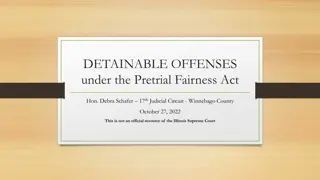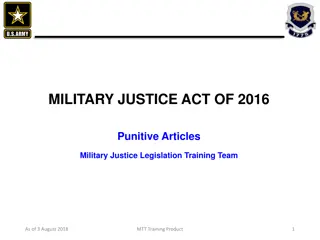Exploring Community Justice Interventions for Alcohol-Related Offenses
This presentation delves into the various community justice options available for individuals involved in alcohol-related offenses. It outlines the justice process post charges, community justice programs, national policies, successful examples like CPOs with alcohol treatment, challenges faced, and the desired improvements within the criminal justice system. The focus is on optimizing diversion and intervention, enhancing community interventions, accessibility of services, and strengthening partnerships. Examples such as Alcohol Problem Solving Courts, Alcohol Monitoring, Peer Support Groups, and Managed Alcohol Programmes are discussed alongside statistics on Alcohol Brief Interventions delivered in different regions.
- Community justice
- Alcohol interventions
- Criminal justice system
- Diversion programs
- Alcohol-related offenses
Download Presentation

Please find below an Image/Link to download the presentation.
The content on the website is provided AS IS for your information and personal use only. It may not be sold, licensed, or shared on other websites without obtaining consent from the author. Download presentation by click this link. If you encounter any issues during the download, it is possible that the publisher has removed the file from their server.
E N D
Presentation Transcript
Alcohol (In)Justice
Brief Outline of justice process once charges laid (bail/remand/sentencing) Community justice options What is supposed to happen, if anything (i.e. national policy) Examples of what is working well (e.g. CPOs with alcohol treatment?) What is not working and why What CJS would like to see happen and how Capturing Community Justice: Unpaid Work Team member helping with gardening tasks at Bellahouston Park with a supervisor from Sacro
1. Optimise the use of diversion and intervention at the earliest opportunity 2. Ensure that robust and high quality community interventions and public protection arrangements are consistently available across Scotland 3. Ensure that services are accessible and available to address the needs of individuals accused or convicted of an offence 4. Strengthen the leadership, engagement, and partnership working of local and national community justice partners Justice Journey illustrations: Diversion from Prosecution and Community Payback Order. A Victim s Journey, Long-term and short-term prison sentence also available. These illustrations are intended to help bring greater understanding of the complexities those involved with the justice system face.
Community Justice Options Alcohol Brief Interventions (ABIs) Target to deliver 20% of ABIs in wider settings. However, what constitutes an ABI varies greatly, very little evidence of effectiveness in the various stages of the criminal justice system due to the lack of follow-up data. Alcohol Problem Solving Courts - Sheriff Fleming, FDAC in England and Wales, international examples. Alcohol Monitoring - Rehabilitation Options Limited but there are great centres CJSW support Peer Support Groups (SMART Recovery, AA, etc., ) Managed Alcohol Programme - Capturing Community Justice: Unpaid work teams created a butterfly mural in Freuchie, Fife, for a residential home for children to brighten up a wall to the garden play area.
Criminal Justice Setting 2017/18 2018/19 2019/20 A.B.I Total 6488 4979 5023 Custody Suites 2439 2290 2373 Prisons 3263 2282 1992 Social Work 786 379 641 Police 0 28 17 Figures from Grampian not included Data pre covid Obvs! Capturing Community Justice: Group sessions at Phoenix Futures provide opportunity for mentoring and reflection
Custody Suites Prisons Social Work Police Total A.B.I 2019/ 20 2373 1992 641 17 5023 Greatest number of ABIs delivered in: Lothian (1330) Greater Glasgow and Clyde (1169) Forth Valley (655) Ayrshire and Arran (684) <100 ABIs delivered in: Highland (0) Orkney (24) Shetland (0) Tayside (79) Western Isles (5) Capturing Community Justice: Social worker Lisa will sometimes schedule informal meet ups in places such as Pittencrieff Park, Dunfermline for people using justice services.
2023 CPO Report Findings: Examples of what is working well (e.g. CPOs with alcohol treatment?) alcohol or drug treatment requirement is to ameliorate dependency. The number of alcohol and drug treatment requirements is low, requirements constituting just over one percent as a proportion of all orders issued in 2021-22, and requirements just under one per cent. with alcohol drug treatment BUT SW tell me that this does not mean that people don t receive alcohol treatment its just not on as an order. Capturing Community Justice: Young person learns about bike maintenance at Heavy Sound
Integrated Recovery Workers within Justice Social Work Departments Examples: - Falkirk - Aberdeen - Perth and Kinross What s working well? Substance Use Transition Support Examples: - Dundee Alcohol Problem Solving Courts - Edinburgh (although Frank Crowe Retired) - Glasgow Recovery Communities and Recovery Coaching Capturing Community Justice: Women from the Connect service in East Lothian have an educational and wellbeing session
Lack of services and assets within communities Knowledge of and access to services can be challenging Lack of Outreach Opportunities Poor understanding of what is being delivered (particularly in relation to ABIs) A lack of residential rehab options although more availability and differing service Harper House, Leap, Jericho, Abbeycare and others. What s not working A lack of buy in/implementation for innovative approaches
Aim : To deliver the first and only uniquely Scottish Managed Alcohol Programme To deliver a national demonstration project in Scotland using best practice from Canada to develop a model of practice to match the unmet needs of people with chronic alcohol dependency and risk of rough sleeping. The MAP provides unique personalised permanent accommodation in specially designed accommodation. Staff and NHS partners use a harm reduction approach that aims to improve and promote a better quality of life for the individuals we support. Our 10 bedrooms provide a psychological informed environment with each room uniquely designed to create a calm, stress free and safe environment. We aim to develop a Scottish evidence based model of practice that can be applied across multiple living and housing options.
Who is the MAP designed for? History of chronic harmful drinking and/or street drinking High levels of alcohol consumption; Chronic homelessness/rough sleeping; Frequent public intoxication; Multiple attempts at treatment; Frequent use of criminal justice and/or health services; Demonstrates motivation to engage with the programme Must not have a diagnosis of ARBD or impaired cognitive functioning.
7 Individuals identified in Glasgow Long term homeless 1630 entries on crime system Rarely as a victim (poor witnesses) Portrait No 1
History of binge drinking, high levels of consumption Chronic homelessness Frequent public intoxication - Frequent rapid detox within prison high use of police and/or health services in one case we had over 400 transfers from City centre to GRI by ambulance. Police assault a common occurrence.
Managed Alcohol Recovery PIE Home Environment Under one roof triage service The Pour Lived Experience peer to peer support Safe Secure & Sustainable APPROACH MAP Connected Community Assets Personal Housing Plan model Partnerships, joint working. Service User led service Collaboration & Inreach Services personalised trauma informed
Each Journey Is Different Estimated weekly units of alcohol before MAP:164 units Average weekly units 3 month after admission at MAP 73 units Each man determines their drink and brand of choice and works with the team to look at when and how they want to manage their intake over the course of the day in line with their experience of withdrawal symptoms We have seen some reduction to relatively low levels of 4-6 cans of regular lager per day already, as they have a stronger desire to be able to engage more in social and relationship based activity.
One mans experience A is a 43 year old male with a long history of alcohol dependency and regular A&E admissions due to seizures and falls. Prior to coming into the MAP service A reported that he was drinking an estimated 30 cans of lager and up to one bottle of Vodka per day, kept a poor diet, poor mobility, low self esteem and did not engage with services. A agreed with staff and addiction nurses that his minimum safe level would be 10 cans of lager per day. Over the course of the next few months A improved his health and mobility. He began to focus more on his health, attending the dentist, GP, accepting Pabrinex injections, and developing skills through healthy cookery sessions. Socially he has taken up guitar lessons, engaged with family and started poetry with support from staff. He has had three A&E admissions since entering the MAP (4 months) service due to falls in the community, versus multiple per week at times before. The relief of knowing A is somewhere he can get the help he needs has lifted a lot of the dark clouds that hung over us for many years. I honestly believe if A was not where he is right now, he would possibly be dead, as the months leading up to him being accepted on this new scheme, he was on very quick decline. relative I have more ups than downs since coming to the MAP - A
Alcohol Monitoring Context 24/7 Tests sweat every 30 mins Voluntary Rolled out England and Wales 177,866 people monitored, 700 million tests, used in 1764 courts An average of 95% Adherence Rates, near 100% adherence after 1 failure 70-80% compliance after completion of the programme Case Studies Helped to deal with jail overcrowding and tackle recidivism in Denver Reduced DUI in Dakota Reduced Domestic Abuse in Dakota Used successfully to combat jail over crowding in Marion County Used in probation to help successfully reintegrated into communities Montana HOPE Hawaii Capturing Community Justice: Social worker Rachel checks files in the Fife Social Work Justice Service office
Purposes of EM EM is a tool used to monitor conditions of orders EM is not incapacitative but there is evidence of a deterrence effect Clear split between advocates and sceptics Advocates Universal appeal All stages of the criminal justice process Many types of defendants/offenders Multiplicity of objectives Sceptics Lack of clear purpose Punitive rather than rehabilitative Questions about effectiveness Ethics Net-widening
Objectives of EM Alternative to custody Avoids harms of incarceration and maintains, and potentially builds, community ties Added value Habit-breaking provides structure and excuses to avoid people and situations linked to offending Increased intensity Assists with the management and completion of other requirements Supports transition from custody to the community aiding reintegration Increases victim s and public safety (GPS) Provides concrete evidence of breach Cost reduction























